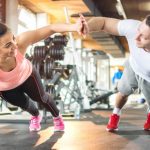Breathing in pilates
“The belief that breathing exercises, or voluntarily controlled breathing patterns, may provide health benefits or enhance physical performance has been shared by many cultures for centuries. The proposed benefits range from enhanced relaxation and decreased stress to lowered blood pressure, improved focus, activation of specific muscles, better circulation and respiration, and even lowered risk for cardiovascular disease. “-www.humankinetics.com. Pilates uses three breathing techniques to foster the benefits that breathing has on the body: lateral breathing, set breathing, and active breathing.
Lateral breathing also referred to as intercostal breathing focuses on the lateral expansion of the rib cage on the inhale but maintains an inward pull which engages the abdominal muscles. This is a sharp contrast to diaphragmatic breathing where the abdominal muscles are relaxed throughout the breath. Lateral breathing is used in Pilates as it keeps the abdominal muscles engaged which helps to stabilize your core.
Any exercise where the inhalation occurs during one part of the exercise and the exhale occurs on another part of the exercise would also be considered set breathing. These breathing patterns prevent you from holding your breath during the exercises which is important as you need to keep oxygen flowing to the muscles in order to get all the benefits of your workout. Set breathing is also used to activate the muscles, a dynamic exhale can activate the transversus abdominis. This ability to train these hard to train muscles is part of the reason Pilates has become so popular. In addition to encouraging breath, and activating muscles set breathing can also set the rhythm of a Pilates exercise. Because some Pilates exercises focus on slow and smooth movements, while others encourage quick and precise movements set breathing is incredibly useful to help set and communicate the correct pace.
A frequently used example of breathing is the “hundreds” exercise. Where you inhale sharply for five counts, and exhale sharply for 5 counts. Alternating this even set of inhales and exhales until you reach a total count of 100 breaths. In active breathing the breath dramatically impacts the exercise. In the example of the “hundreds” the breath is pushed out forcefully on the exhale as a way to contract the abdominals and the intercostals. On the inhale the breath is drawn in to activate the external intercostals.
Strengthening your respiratory muscles will make it easier to apply breathing techniques throughout the duration of a Pilates practice, it will also help to strengthen your core. These are two of the most challenging factors even fit people face when they start practicing Pilates. Like most exercise routines it will become easier with time and you will continue to discover new ways to challenge your body with Pilates. However, you can also take steps to strengthen your respiratory muscles prior to your practice so that you can see results faster. Using a breathing exerciser like Expand-A-Lung will strengthen your diaphragm and your intercostals. The inspiratory and expiratory resistance will show you how your respiratory muscles react, engage, and activate which will give you more muscle awareness and allow you to adapt to different breathing techniques with more ease.




